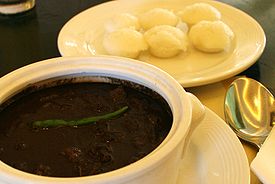- Dinuguan
-
Dinuguan
A bowl of dinuguan and a plate of puto.Origin Place of origin Philippines Dish details Course served Main course Serving temperature Hot Main ingredient(s) Pork, pig's blood, vinegar, garlic, siling mahaba Dinuguan (also called dinardaraan in Ilocano, tid-tad in Pampanga, sinugaok in Batangas, rugodugo in Waray, and sampayna or champayna in Northern Mindanao. Possible English translations include pork blood stew, blood pudding stew, and chocolate meat)[1] is a Filipino savory stew of meat and/or offal (typically lungs, kidneys, intestines, ears, heart and snout) simmered in a rich, spicy dark gravy of pig blood, garlic, chili (most often siling mahaba), and vinegar.[2] The term dinuguan comes from the Filipino word dugo meaning "blood".
It is frequently considered an unusual or alarming dish to most people, though it is rather similar to European-style blood sausage, or British black pudding in a saucy stew form.[3] It is perhaps closer in appearance and preparation to the Polish soup Czernina or an even more ancient Spartan dish known as melas zomos (black soup) whose primary ingredients were pork, vinegar and blood.
Dinuguan can also be served without using any offal, using only choice cuts of pork. In Batangas, this version is known as sinungaok. It can also be made from beef and chicken meat, the latter being known as dinuguang manok ('chicken dinuguan').[3][4] Dinuguan is usually served with white rice or a Philippine rice cake called puto.[3]
See also
- Beutelwurst
- Blood soup
- Saksang
- Svartsoppa
References
- ^ Emily Ignacio (2005). Building diaspora: Filipino community formation on the Internet. Rutgers University Press. ISBN 9780813535142. http://books.google.com/books?id=R-I52mGEZ6UC&pg=PA125&dq=dinuguan&hl=en&ei=iMWuTar2IofuuAPD0PyPDw&sa=X&oi=book_result&ct=result&resnum=4&ved=0CDoQ6AEwAw#v=onepage&q=dinuguan&f=false.
- ^ Margarita Marquis (2007) (in French). La Cuisine des Philippines. Editions Publibook. ISBN 9782748335064. http://books.google.com/books?id=L0bmbwW_DLUC&pg=PA65&dq=dinuguan&hl=en&ei=iMWuTar2IofuuAPD0PyPDw&sa=X&oi=book_result&ct=result&resnum=3&ved=0CDUQ6AEwAg#v=onepage&q=dinuguan&f=false.
- ^ a b c Alan Davidson & Tom Jaine (2006). The Oxford companion to food. Oxford University Press. ISBN 9780192806819. http://books.google.com/books?id=JTr-ouCbL2AC&pg=PA251&dq=dinuguan&hl=en&ei=XMWuTZGyBoOGvgOc9smGDw&sa=X&oi=book_result&ct=result&resnum=1&ved=0CCcQ6AEwAA#v=onepage&q=dinuguan&f=false.
- ^ "Dinuguan a la Ate Angelina". MarketManila. July 26, 2006. http://www.marketmanila.com/archives/dinuguan-phobia.
Philippine cuisine Individual dishes Desserts - See also: List of Philippine dishes
- Philippine condiments
- Kapampangan cuisine
- List of Philippine restaurant chains
Categories:- Offal
- Stews
- Blood dishes
- Philippine cuisine
Wikimedia Foundation. 2010.

